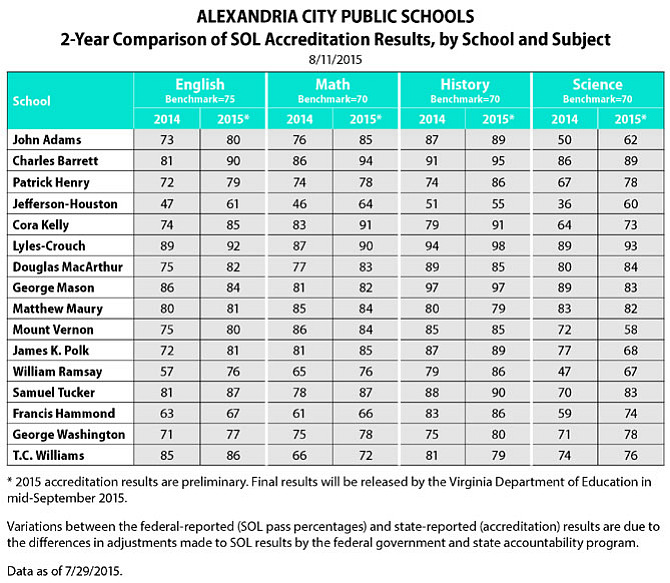The forecast calls for sunshine, but make no mistake it’s raining test scores these days, and improved numbers for schools are sprouting over town. The Virginia Department of Education has just released preliminary SOL test results for the 2014-2015 school year, and Alexandria City Public Schools show pass rates up across English, math, history and science. In English and math, the focus for Superintendent of Schools Dr. Alvin Crawley this past year, scores have increased or remained stable for almost all of the schools.
“We are very pleased with the accomplishments of our students,” said Crawley. The increases may also serve as validation of Crawley’s efforts during his tenure since beginning as interim superintendent in October 2013 and his subsequent hire in March 2014. This is the first full academic year of test scores under Crawley reign, and the results show broad improvement. Crawley attributes the rise to “strengthened instructional practices, increased teacher training focused on specific student needs and frequently monitored student performance.”
Fourteen out of 16 schools saw increases in English and math. Nine schools saw increases in history. Twelve schools have increases in science.
“I’ve seen nothing like this in the time I’ve served on the board,” said Karen Graf, chairman of the School Board, when describing the latest improvements in test scores. She hopes it can be a key element in efforts to “make sure that we are changing the dialogue about the schools,” said Graf.
Some of the notable gains were made in schools where it was most needed and among students with typically lower SOL pass rates. William Ramsay Elementary, designated Accredited with Warning, saw gains in English, with SOL pass rates up 19 percent for Black, 16 percent for Latino, 17 percent for Low Income, 16 percent for ELL and 29 percent for Students with Disabilities. The school also had standout gains in history, with increases of 21 percent for Black, 22 percent for Latino, 19 percent for Low Income, and 21 percent for ELL students. In math, Ramsay’s gains were more modest, from 1 percent to 7 percent across categories.
Patrick Henry Elementary School, which was also Accredited with Warning, saw gains in English, math and history. Scores were up in almost every demographic category. In English, Patrick Henry showed increases in SOL pass rates of 3 percent for Black, 29 percent for Latino, 14 percent for Low Income, 27 percent for ELL and 10 percent for Students with Disabilities. In math the gains were 1 percent for Black, 14 percent for Latino, 10 percent for Low Income, 12 percent for ELL and 13 percent for Students with Disabilities.
T.C. Williams High School showed spotty gains. Scores dipped in reading, writing and history yet improved in mathematics. There were drops in English: Writing pass rates for Latino and ELL students fell 10 percent and 16 percent respectively. There was a 15 percent rise in mathematics among students with disabilities.
The district’s sole unaccredited school, Jefferson-Houston, saw a 12 percent increase in reading pass rates overall, up 18 percent and 11 percent among Black and Low Income students respectively. In math, scores increased 18 percent overall, up 20 percent for Black and 12 percent for Latino and 17 percent for ELL students. In science the numbers were up 26 percent for all students, with increases of 37 percent for Black, 30 percent for Latino and 41 percent for ELL students. These were much needed gains after a significant dip in science scores in the prior year. The increases were so strong they surpassed the year one projections for the schools 3-year plan for full accreditation: The school made two years of progress in one year’s time.
Although Crawley’s focus on improving math and English outcomes has shown success, the results also show daunting challenges remain. Although there have been significant percentage increases some test scores remain low — particularly for students with disabilities, whose pass percentages improved slightly but overall were low with a 50 percent pass rate or below in most core subjects in the majority of ACPS schools. Also, the gap between white student achievement and that of Black and Latino students persists.
Still, as September approaches, Crawley begins the new school year with the wind at his back. “ACPS has made some significant gains. Although there are areas that still need improvement, we are working to build on our momentum for the coming school year. We continue to focus on equitable pass rates across all our schools, our subject areas and our gap areas,” Crawley said.
